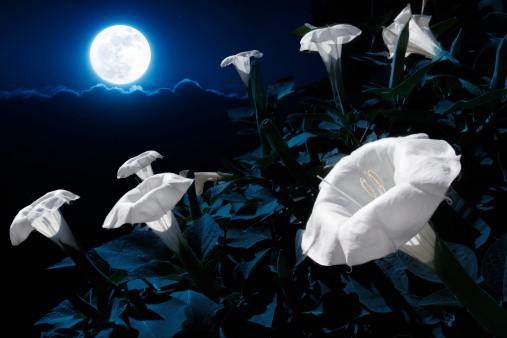This wonderfully peculiar flower earns its name from how it blooms. The flowers open within minutes at dusk and close at the sight of the morning sun. The flowers are pure white and reveal a pale green star and light scent at night. They are also prized for their sizable heart-shaped foliage and fast climbing habits, making them a top choice for hiding fences or filling trellises.
Moonflower is a member of the Ipomoea alba family, and is classified as an annual flower. Its genus name, Ipomoea, originates from the Greek word ipomea meaning ‘’worm-like’’ in allusion to the twining stems of morning glories, while alba refers to the white color of this variety’s flowers. As a result of its unique characteristics and quick growth, Moonflower has become a symbol of optimism, innocence and persistence.
Meaning and Symbolism
Moonflower has been celebrated for centuries in various works of literature and art. In the East, its symbolism is especially captivating. Its ability to bloom only at night has been linked with moonlight and the mysteriousness of darkness. In Taoist teachings, Moonflower has been associated with the primordial Yin energy which is also seen in shadow, moonlight and femininity. In Christian iconography, Moonflower is often associated with the Virgin Mary, due to its white petals that recall the sacred union between divine and mankind.
Apart from its spiritual significance, the Moonflower is also an important source of inspiration. It has been a symbol of spiritual awakenings, self-discovery and mindfulness, reminding people of how to take full advantage of life’s opportunities. In some cultures, moonflowers are also seen as a symbol of happy times and prosperity as they are believed to bring beauty wherever they are planted.
History, Mythology and Religious Significance
The Moonflower has historically been used for a variety of purposes, including medicine, decorative purposes, and even prayer. As an ingredient, the moonflower is highly valued due to its ritualistic and medical properties. Cuttings from the vines were used in India and China in the treatment of wounds, insomnia and malaria, while the white petals were used in quite diverse medical potions. In Spanish American mythology, moonflowers were also seen as a means of calling the power of good spirits in protection rituals.
In Christianity and more particularly Islam, Moonflower was thought to be the source of purity and could be used as a pardon for sins. This belief was especially popular in the Middle East and predates Christianity, as the white petals were thought to purify a person’s soul. Overall, it was a popular flower in religious ceremonies and rituals.
Flower Varieties and Defining Characteristics
The Moonflower has numerous varieties, each with its own defining characteristics. The most popular and widely available varieties are the Grandpa Ott, Heavenly Blue, and Lucida Mexicana. The Grandpa Ott Moonflower has white trumpet-shaped flowers and large heart-shaped foliage, making it one of the most popular. The Heavenly Blue variety, on the other hand, has sky blue flowers with a sweet, faint aroma and a fast-growing nature.
The Lucida Mexicana variety is perhaps the most unique and is often sought-after due to its striking yellow or white petals that fade to a deep blue at dusk. Additionally, all varieties of the Moonflower are associated with long life and it is often sought-after as a birthday or anniversary present.
How to Plant
Moonflower is a fast-growing, hardy flower. It prefers sunny spots with moist, well-drained soil and low wind exposure. For outdoor containers, use a high-quality, lightweight potting soil mix with a balanced fertilizer and good drainage. If planting indoors, use a slightly richer soil and make sure the pot has drainage holes to prevent waterlogging. It prefers temperatures between 40-80° F and is moderately drought tolerant.
When it comes to pruning, with Moonflower less is more. A light trim in the late winter or early spring can be performed to increase the number of blooms and leave room for new growth. It is also important to wait until flowering has reached its peak before pruning, as pruning it too early can reduce the amount of blooms.
How to Propagate
Propagation of the Moonflower can be done through both seeds and cuttings. Cuttings can be taken in the early spring or late fall and placed in a moist peat and perlite mix. Make sure that the cuttings are kept moist, around 70-80°F, and placed in a spot with indirect sunlight. The cuttings will soon root and can be transplanted into individual pots.
Seeds can be harvested from mature Moonflower flowers. Take the seed pods off the flowers and let them dry before storing them in an airtight container in a cool, dark space. The seeds should be planted in the spring or fall in well-draining soil. Plant them shallowly – about ¼ inch deep – and make sure to keep the soil moist. The seeds will soon germinate in about two weeks and will start flowering within a few months.
Common Pests and Diseases
The Moonflower is susceptible to a range of common pests and diseases. Aphids, spider mites, and many caterpillar species can cause significant damage to the foliage if not treated in a timely manner. To combat these pests, spraying a mixture of neem oil, insecticidal soap, or other natural insecticides can be beneficial. In addition, the Moonflower is susceptible to fungal diseases such as powdery mildew, which can be combated by regular pruning and irrigating the plant at its base, instead of on its leaves.
Table Fact Sheet
| Moonflower | Ipomoea alba |
|---|---|
| Family | Convolvulaceae |
| Plant Type | Annual |
| Mature Size | Varies by variety |
| Sun Exposure | Full Sun |
| Soil Type | well-drained |
| Soil pH | 6.0-7.0 |
| Bloom Time | Summer/Fall |
| Flower Color | White/Yellow/Blue/Purple |
| Hardiness Zones | 8-11 |
| Native Area | Warm temperate and tropical regions |
Frequently Asked Questions (FAQ)
Q: Do Moonflowers need to be planted in well-drained soil?
A: Yes, Moonflowers need to be planted in moist, well-drained soil in order to thrive.
Q: Can Moonflowers live in cold climates?
A: Yes, though Moonflowers prefer warm climates, some varieties of the plant can thrive in cold climates, as long as temperatures do not go below 40°F (4.4°C).
Q: How often should Moonflowers be watered?
A: Moonflowers should be watered when the soil is starting to dry. Keep in mind that too much water can be harmful, so be sure to check the soil every few days.
What we love from Amazon this week
Buy these wonderful flowers directly from Amazon:















